QSR vs Cloud Kitchen: The Basics & Differences Covered!



Table of Contents
Table of Contents
- Overview
- What is QSR
- What is Cloud Kitchen
- QSR vs Cloud Kitchen: The Major Differences Between the Two Restaurant Types!
- QSR vs Cloud Kitchen: The Cost Differences
- QSR vs Cloud Kitchen: The Size Differences
- Pros & Cons of Cloud Kitchen
- Pros & Cons of QSR
- What are the Challenges and Feasible Solutions for Cloud Kitchen?
- What are the Challenges and Feasible Solutions for QSR?
- Conclusion
- Frequently Asked Questions(FAQs)
“Quick summary” The restaurant industry is an exciting one. It brings up so many exciting opportunities for food enthusiasts and entrepreneurs. However, it is vast and there are so many interesting formats to choose from. You have already heard about QSRs(Quick-Service Restaurants), which provide high-quality meals quickly and efficiently. The well-known examples are McDonald's and Starbucks.
But, now(especially) after the pandemic, where more and more customers are loving the convenience of ordering from the comfort of their home or booking drive-thru - Cloud Kitchens are growing in popularity at a first pace.
Cloud kitchens are basically a type of restaurant operating with just a commercial kitchen without a dine-in facility. Customers can place their orders through their devices and get them delivered to their homes or even choose to pick them up directly from the cloud kitchen.
To know more about how these two restaurant types differ and which one you should start based on different factors, keep reading.
What is QSR
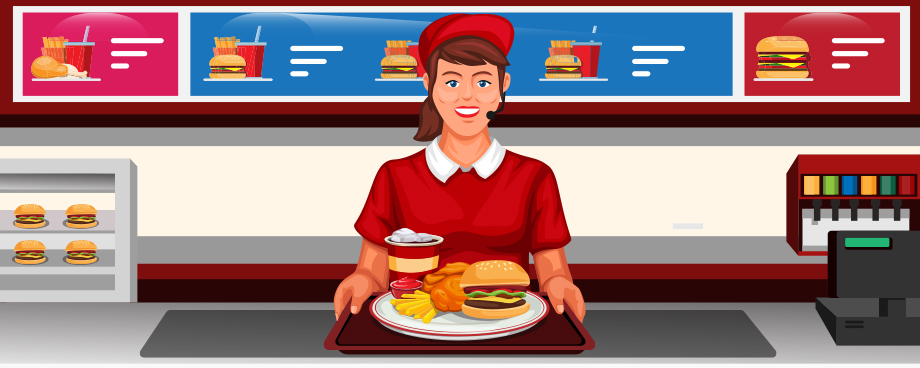
Fast food restaurants, often known as quick service restaurants (QSRs), provide certain dishes that can be prepared and served quickly. Quick service restaurants, or QSRs, often serve fast food items from a small menu since they can be prepared quickly and with the least amount of variance.
Why are QSRs Popular
QSR restaurants are renowned for having standardized, flexible, and effective systems that enable them to fulfill orders faster while maintaining the high level of service that customers have come to expect. Fast food restaurants (QSRs) rely heavily on their preparation techniques and use of technology. Quick-service restaurants have a wide variety when it comes to the type of service they offer.
How Does QSR Work
There are also drive-through restaurants, which just have a single counter for taking orders and delivering food instead of having any tables or chairs. Orders are typically pre-prepared and extremely standardized, with little option for personalization.
The Fundamental Approach of QSR
Bundled pricing is a fundamental approach utilized by fast-service restaurants. QSR combines menu components into a package of complementary meals.
Let's look at a simple example: a McDonald's value meal consisting of fries, a soft drink, and a burger. Customers typically choose these meals over single food items because they feel like they are getting more value and variety for their money.
Retailers benefit from higher average customer value and significant profit margins when they provide enticing discounts over bundled meals.
Types of QSR
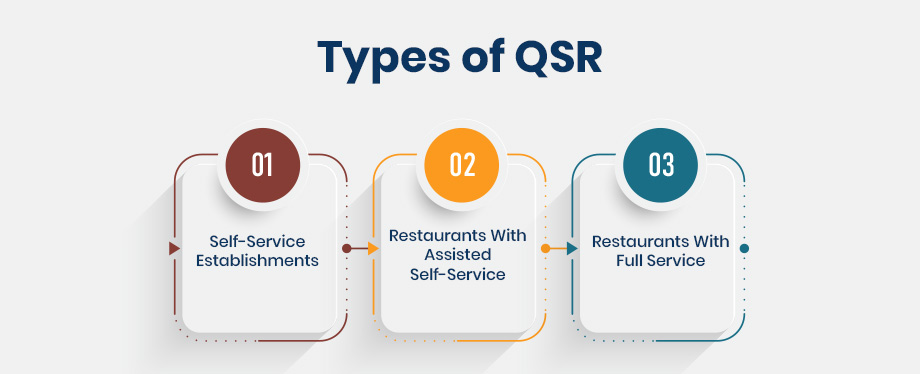
- Self-Service Establishments: In this kind of quick service restaurant, customers come to the ordering counter to place and pick up orders. After the order is ready and they are informed, they retrieve it independently from the counter.
- Restaurants With Assisted Self-Service: These QSRs are locations where customers can either pick up their orders at their table or have staff members deliver the meal to their table.
- Restaurants With Full Service: These are the locations where the worker at the table takes both orders and delivers meals.
What is Cloud Kitchen

A cloud kitchen, often called a "virtual kitchen" or "ghost kitchen," is a type of commercial kitchen and delivery-only establishment without actual storefronts or customer dining rooms offering a variety of menu options to the customers.
Cloud kitchens were experiencing a 13.78% annual growth rate, which led to more excitement. According to Statista's most recent estimate, the market will grow by twofold from 2021 to 2027, reaching $112.53 billion.
How Does Cloud Kitchen Work
Consumers can place orders straight from the virtual restaurant through their app, website, or phone number, or they place orders online via meal delivery services like Grubhub, Doordash, etc. Drivers pick up the food from production facilities, often known as "ghost kitchens," where it is prepared before being delivered to clients.
The Strategic Business Model For Cloud Kitchens
With the cloud-kitchen business model, one or more virtual restaurants can run from a kitchen optimized for delivery, eliminating the need for a dining area or front-of-house employees, saving resources, and offering high-quality meals at affordable rates.
Types of Cloud Kitchens
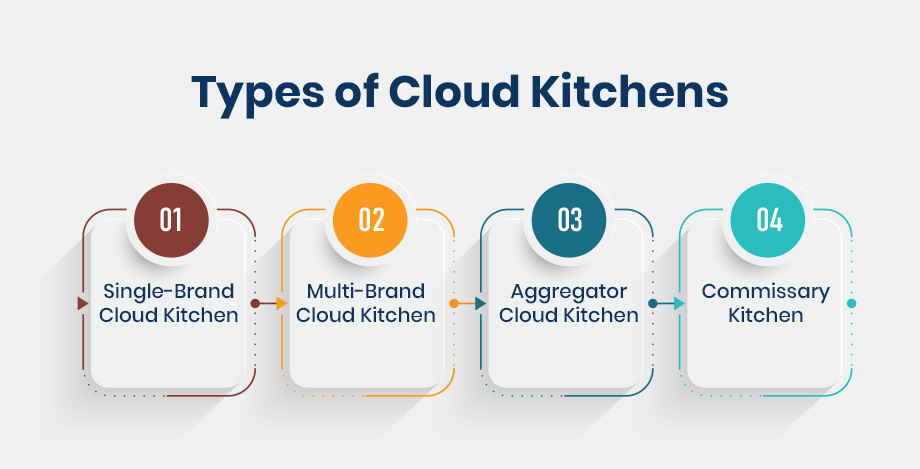
- Single-Brand Cloud Kitchen: Operates under a single culinary brand, offering a specific type of cuisine or a particular food concept.
- Multi-Brand Cloud Kitchen: It includes multiple restaurant brands or concepts within the same kitchen space, allowing for diverse menu options.
- Aggregator Cloud Kitchen: Provides kitchen space and services to multiple restaurant partners, enabling them to fulfill online orders without establishing their physical kitchen.
- Commissary Kitchen: A shared kitchen facility where multiple food businesses rent space to prepare and cook their menu items, reducing costs and increasing efficiency.
QSR vs Cloud Kitchen: The Major Differences Between the Two Restaurant Types!
Starting a successful restaurant business is not easy. It requires comprehensive planning and research to get on the right foot while ensuring the long-term profitability of your restaurant business.
The major differences between these two establishments are operational models, marketing strategies, costs, technology, and so many other things. Careful consideration of the unique attributes of each type is crucial for entrepreneurs to ensure alignment with business goals and target markets.
QSR vs Cloud Kitchen: The Cost Differences
The cost difference between cloud kitchens and quick service restaurants (QSRs) can vary significantly based on factors such as location, scale, concept, and operational requirements, which significantly affect the total costs of starting and operating a restaurant.
Cloud Kitchen
- Start-Up Costs: Cloud kitchens are generally more cost-effective to start compared to traditional QSRs. The startup costs can range from $50,000 to $500,000 or more, depending on the scale of the operation, kitchen equipment, technology infrastructure, and branding. The lower start-up costs are due to the absence of physical dining space, lesser space requirements, and the potential for shared kitchen facilities.
- Operating Costs: The ongoing operating costs for a cloud kitchen include rent for kitchen space, utilities, staff wages, marketing, and technology expenses. On average, monthly operating costs can range from $5,000 to $50,000 or more, depending on the size and scale of the cloud kitchen.
Quick Service Restaurant (QSR)
- Start-Up Costs: QSRs generally have higher startup costs compared to cloud kitchens due to the need for a physical storefront, seating areas, and additional amenities. The startup costs for a QSR can range from $100,000 to $1 million or more, depending on factors such as location, size, kitchen equipment, interior design, and branding.
- Operating Costs: The ongoing operating costs for a QSR include rent, utilities, staff wages, food supplies, marketing, and maintenance. Monthly operating costs for a QSR can vary widely but may range from $10,000 to $100,000 or more, depending on the size, location, and scale of the restaurant.
QSR vs Cloud Kitchen: Location
Location is quite important for any business. However, the requirements for each business vary. For quick-service restaurants, the priorities are high traffic and accessibility. On the other hand, the priorities of location for cloud kitchen are near your target audience and at the center to restrict the radius.
Quick Service Restaurants (QSRs)
Selecting an optimal location for a quick service restaurant (QSR) involves considerations beyond accessibility for delivery drivers. QSRs benefit from high-visibility areas with substantial foot traffic, aiming to attract walk-in customers.
Proximity to shopping centers, business districts, or busy streets is often preferred to enhance visibility and capitalize on spontaneous dining decisions. Parking availability and ease of access are crucial factors, ensuring a seamless experience for patrons who choose to dine in.
Cloud Kitchens
In contrast, choosing a location for a cloud kitchen is less dependent on high-visibility areas. Since cloud kitchens operate primarily for online orders and deliveries, they can be strategically placed in more cost-effective locations with lower rent.
In cloud kitchens, proximity to densely populated residential areas, key delivery partners, and efficient logistics are topmost priorities. Cloud kitchens can thrive in less conventional locations, focusing on operational efficiency rather than walk-in visibility.
QSR vs Cloud Kitchen: The Customer Approach
The customer approach in cloud kitchens and Quick Service Restaurants (QSRs) differs significantly, because of their different format, business models, and approach.
Cloud Kitchen
- Digital-First Interaction: The primary customer approach for cloud kitchens is digital-first. Customers typically discover and interact with cloud kitchens through online platforms and mobile apps. The entire ordering process, from menu browsing to payment, is facilitated digitally.
- Delivery and Takeout Focus: Cloud kitchens prioritize delivery and takeout services, aiming to fulfill orders quickly and efficiently. The focus is on providing a seamless online ordering experience and ensuring that the delivered food maintains its quality during transit.
- Limited or No Dine-In: As cloud kitchens often lack a physical storefront or dine-in area, the customer approach is centered around creating a strong online presence, enticing customers through visually appealing menus, and delivering a positive experience through efficient and accurate order fulfillment.
Quick Service Restaurant (QSR)
- In-Person Interaction: QSRs traditionally include in-person interactions between customers and staff. Customers can walk into the restaurant, peruse the menu, place orders at the counter, and interact with front-of-house staff. QSR also offers (sometimes) drive-thru services and take away counters as well.
- Dine-In Experience: QSRs often provide a dine-in experience, emphasizing a welcoming ambiance, cleanliness, and customer service. The approach includes creating an environment where customers feel comfortable enjoying their meals and may encourage them to linger.
- Multichannel Presence: While QSRs also leverage online ordering and delivery services, the customer approach extends beyond the digital realm. QSRs maintain an exciting physical presence and it shapes the customer experience through online interactions and the atmosphere within the physical restaurant.
QSR vs Cloud Kitchen: The Staffing Differences
Navigating the differences in staffing between Quick Service Restaurants (QSRs) and Cloud Kitchens is crucial for effective operations in these unique restaurant models.
Quick Service Restaurants (QSRs)
In the world of QSRs, staffing needs are diverse to meet both front-of-house and kitchen requirements. Front-of-house roles, including cashiers and servers, are vital for delivering positive in-person dining experiences. Simultaneously, the kitchen team ensures timely and quality meal preparation.
This dynamic staffing structure contributes to a holistic customer service approach within the physical restaurant space. The diverse requirements and unique customer approach, require (comparatively) higher employees and costs.
Cloud Kitchens
Operating in a digital-first environment, Cloud Kitchens optimizes their staffing to align with the unique demands of online orders. A specialized team is key, with cooks efficiently preparing orders, order processors managing online requests, and delivery personnel ensuring prompt and accurate deliveries.
Minimizing front-of-house roles due to the absence of dine-in, technology takes center stage. So, you need someone who can manage the online orders and delivery while also facilitating seamless order processing and communication. So, the requirements for staffing and their costs are comparatively lesser for cloud kitchens.
QSR vs Cloud Kitchen: The Size Differences
The size difference between cloud kitchens and quick service restaurants (QSRs) is one of the major distinctions. Cloud kitchens, being virtual or delivery-centric, typically require significantly less physical space compared to traditional QSRs.
Cloud Kitchen
Cloud kitchens operate with a considerably smaller footprint compared to QSRs. They can function in shared kitchen spaces or commissaries, often requiring only kitchen infrastructure and space for order fulfillment.
The focus is on optimizing kitchen efficiency rather than dedicating space to a dine-in area, as they offer only online deliveries and drive-thru options for customers. The average area for a cloud kitchen can range from 500 sq ft to 2000 sq ft, depending on the scale and capacity of the operation. Smaller ones have an average area of 500 to 800 and larger ones have an area of 1000 to 2000 sq ft.
Quick Service Restaurant (QSR)
QSRs, with their traditional storefronts and dine-in spaces, generally occupy larger physical footprints. The average size can vary widely based on the concept, menu offerings, and seating capacity.
Typically, a QSR area might range from 800 to 3,000 square feet or more, including kitchen, dining, and service areas. QSRs that are offering drive-thru and takeaway-only options can reduce the overall size compared to those with only dine-in facilities.
All in all, cloud kitchens focus on efficiency and delivery, due to which they can operate in smaller spaces optimized for only kitchen activities. On the other hand, QSRs have their physical storefronts and dining spaces, which usually require larger areas to accommodate both kitchen operations and customer seating.
QSR vs Cloud Kitchen: Technology
Choosing the right technology and tools has become a necessity for all businesses, especially restaurant businesses. However, choosing the right type of tech based on your business and customer requirements is important.
Cloud Kitchen
The future of food delivery lies in cloud kitchen technologies. They employ a combination of technology and human labor to produce meals that can be transported anywhere in the world and enjoyed by consumers from the comfort of their own homes. Due to their completely virtual nature and lack of a real location, the technology is also referred to as "virtual restaurants."
It implies that they can be found anywhere, including the garage! All you need is a few chefs, a single commercial kitchen outfitted with all the necessary tools, a mobile app and website, the ability to register on external websites, and someone to handle and oversee the management of incoming orders. Everything (from ordering and tracking to receiving and delivering) takes place online and it is heavily reliant on technology.
Quick-Service Restaurants
In quick-service restaurants, the experience is paramount. It all comes down to the cuisine, the atmosphere, and the service. It also has to do with technology! You read correctly-technology is also necessary for quick-service restaurants to manage employee information, inventory, and customer data.
In addition, QSRs offer delivery and drive-thru options. They must therefore use the appropriate technologies to handle that as well. In general, QSR's reliance on technology is lower than Cloud Kitchen's.
QSR vs Cloud Kitchen: The Marketing Approach
Understanding the differences between QSR and cloud kitchen marketing is crucial for effectively promoting your restaurant in today's dynamic culinary landscape.
Quick-Service Restaurant
For quick-service restaurants (QSRs), traditional marketing strategies revolve around appealing customers to the physical establishment and ensuring a memorable in-person experience. The QSR owners can achieve this by offering specials, implementing discounts during specific days or times, and introducing seasonal menu items to attract regular patrons.
However, in this digital era, you can’t skip digital marketing as it plays a pivotal role in boosting your brand’s online presence. It helps you showcase the restaurant's behind-the-scenes (BTS), new menu items, discounts, and customer experiences across various online platforms on social media, attracting new customers and even retaining existing ones.
Cloud Kitchen
Conversely, the success of cloud kitchen marketing depends on a robust online presence. A reliable website or mobile app serves as the digital storefront, enabling customers to place orders around the clock. The website or app must be responsive and mobile-friendly to ensure accessibility across various devices.
Unlike traditional dine-in establishments, where customers naturally visit, cloud kitchens rely on proactive marketing to drive online orders and establish a strong digital presence in the competitive food delivery landscape. Utilizing social media, search engine optimization (SEO), listing on third-party platforms, and paid marketing strategies are important to boost the online visibility of a cloud kitchen.
Pros & Cons of Cloud Kitchen
Cloud kitchens are among the most trending and cost-efficient restaurant types for food entrepreneurs. One significant advantage of cloud kitchens is their renowned efficiency in providing quick and effective food service. However, like quick service restaurants (QSRs), cloud kitchens come with their own set of challenges and limitations.
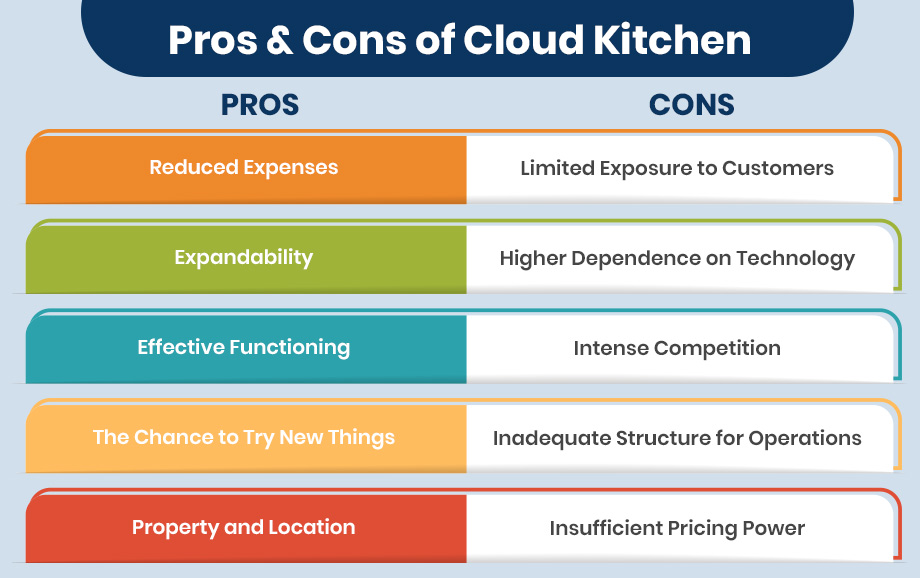
Pros
- Reduced Expenses: Cloud kitchens are far more cost effective than traditional restaurants. Cloud kitchens do not require a real storefront or eating space, so owners can save money on rent, utilities, and upkeep. They rely only on cooking and delivery personnel. Consequently, there are no longer any expenses associated with hosts or servers, which results in reduced labor costs. They also do not necessitate the purchase of expensive dinnerware, decorations, and customized signs.
- Expandability: Cloud kitchens can quickly and easily scale their operations to meet demand. There's no need to worry about physical expansion or hiring more workers to cover a wider dining area when your business takes off and more orders come in. All you'll need to do is add a few more employees and, if necessary, a few more appliances, and you'll be all set.
- Effective Functioning: With a cloud kitchen, you can concentrate solely on food preparation and delivery, avoiding the hustle and never-ending responsibilities of running a typical restaurant and delivering greater quality food at lower rates.
- The Chance to Try New Things: You can experiment with your menu and present fresh concepts and ideas when you operate a cloud kitchen. It helps you attract a broad customer base while also retaining the current ones.
- Property and Location: The primary factor for your consideration of cloud kitchens could be flexibility in terms of location and property. You can operate in spaces like parking lots, basements, warehouses, and other locations that are inappropriate for a regular restaurant. Selecting a location where there is a lot of demand from customers is something to keep in mind, particularly for the kind of food you serve.
Cons
- Limited Exposure to Customers: A difficulty with cloud kitchens is the restricted engagement and experience for customers. Cloud kitchens don't have the same atmosphere or dining experience as traditional restaurants because they exclusively offer delivery services. As a result, developing consumer loyalty and brand recognition is more difficult.
- Higher Dependence on Technology: Cloud kitchens, which use solely ordering platforms and delivery apps, are very dependent on technology. Any technical issues or outages can therefore have a big impact on operations.
- Intense Competition: The market for meal delivery is becoming more competitive as cloud kitchens become more popular. You have to differentiate yourself from the competition if you want to be successful.
- Inadequate Structure for Operations: In virtual restaurants, managers sometimes undervalue the significance of adhering to standard operating procedures (SOP), which creates difficulties for staff management and oversight. Because of this, a sizable portion of online eateries deal with problems including poorly handled orders and delays, unhygienic working conditions, and insufficient food quality control.
- Insufficient Pricing Power: Cloud kitchens cannot justify their excessive costs without the dining experience. If the experience is lacking, customers won't pay the same amount as they would at a conventional restaurant. When placing an order with a cloud kitchen, customers are typically searching for discounts. Nevertheless, as a cloud kitchen, your limited ability to set prices restricts your sales and revenue.
Pros & Cons of QSR
One big benefit of quick service restaurants (QSRs) is their reputation for providing prompt, effective service. In comparison to other kinds of restaurants, they are also less expensive to enter and rather simple to start up. Nevertheless, using a QSR has its drawbacks as well.
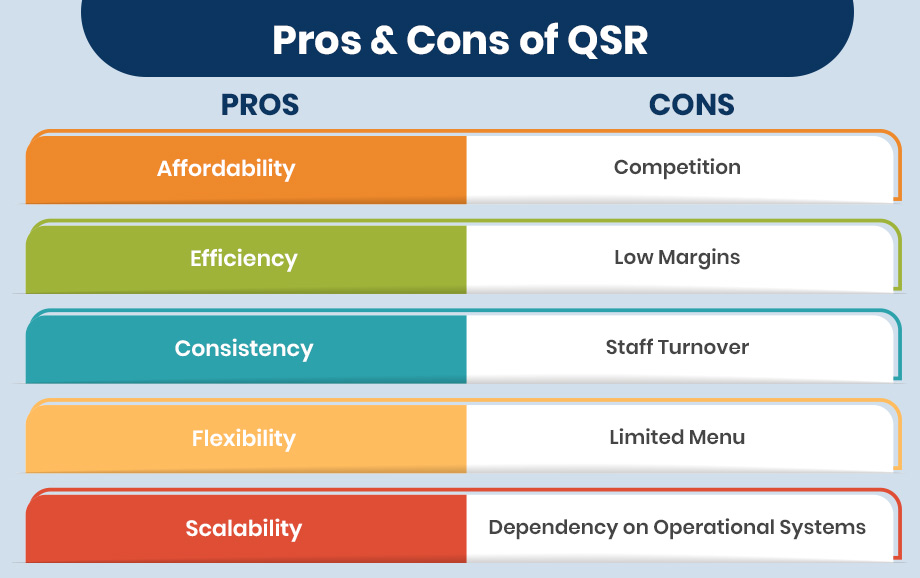
Pros
- Affordability: Quick Service Restaurants (QSRs) have a relatively low cost of entry, making them appealing for aspiring entrepreneurs. The lower initial investment compared to full-service restaurants helps entrepreneurs with limited capital to enter the food industry and get started.
- Efficiency: QSRs prioritize speed and efficiency in their operations. The design and layout of these establishments are focused on quick order processing, minimizing wait times for customers. Fast service is a key attraction for individuals looking for a quick meal, especially during busy work days or on-the-go situations.
- Consistency: One defining characteristic of QSRs is their commitment to consistency. Standardized menus, recipes, and operational procedures are implemented across all locations to ensure a uniform dining experience.
- Flexibility: QSRs exhibit adaptability to different locations and markets, making them a versatile option for entrepreneurs. This flexibility enables them to tailor their offerings to suit local tastes and preferences. QSRs can also easily adjust, such as introducing drive-thru options or partnering with delivery services, to align with evolving consumer trends and demands.
- Scalability: Due to their standardized processes and streamlined operations, QSRs are often easily scalable. This scalability is advantageous for entrepreneurs looking to expand their business across different locations or even through franchise models.
Cons
- Competition: The QSR market is highly competitive, presenting a challenge for new businesses aiming to establish themselves. With numerous players finding ways to get consumer attention, differentiation becomes crucial and somewhat difficult as well.
- Low Margins: Despite high sales volumes, QSRs often operate with low profit margins. This is primarily due to the need to keep menu prices competitive, the cost of quick service, and the challenges associated with bulk purchasing. The slim profit margins can pose difficulties for operations and sustaining the business.
- Staff Turnover: High staff turnover is a common issue in the QSR industry. The nature of fast-paced environments and entry-level positions can contribute to frequent employee turnover. This constant churn requires ongoing recruitment efforts, and increased training costs, and may lead to challenges in maintaining a consistently skilled and motivated workforce.
- Limited Menu: QSRs often feature limited menus, emphasizing a select range of popular and easily producible items. While this approach streamlines operations and enhances efficiency, it can pose challenges in catering to customers with specific dietary requirements or diverse tastes, while also limiting the appeal to a broader customer base.
- Dependency on Operational Systems: The emphasis on efficiency and consistency in QSRs relies heavily on operational systems and processes. Any breakdown in these systems can lead to disruptions in service and impact customer satisfaction.
What are the Challenges and Feasible Solutions for Cloud Kitchen?
- Visibility and Marketing:
- Challenge: Without a physical location, cloud kitchens might find it difficult to gain visibility and market their business.
- Solution: It is surely difficult but everything is possible with the right digital marketing plan. Develop a comprehensive digital marketing strategy. Invest in a professional and user-friendly website that showcases your menu. Leverage social media platforms to engage with your audience and run targeted advertising campaigns.
Quick-Tip: Collaborate with popular food delivery apps to expand your reach.
- Order Fulfillment and Delivery Logistics:
- Challenge: Timely and efficient order fulfillment and delivery are critical but can be logistically challenging.
- Solution: Implement an advanced order management system that integrates with your kitchen operations. Partner with reliable third-party delivery services and optimize delivery routes using data analytics. Regularly assess delivery performance, solicit customer feedback, and make necessary adjustments to enhance efficiency.
- Technology Integration:
- Challenge: Coordinating various technologies for order management, inventory tracking, and kitchen operations can be complex.
- Solution: Invest in a POS system specifically made for that centralizes operations. Ensure compatibility with popular food delivery platforms. Train staff regularly on technology use and implement cloud-based solutions for scalability and ease of integration.
- Quality Control:
- Challenge: Maintaining consistent food quality, especially during transit, is a concern.
- Solution: Establish stringent quality control processes in the kitchen, including standardized recipes and cooking procedures. Optimize packaging to preserve food quality during delivery. Utilize technology like temperature-monitoring devices to ensure food safety. Regularly review and improve quality control measures based on customer feedback.
- Sustainability and Environmental Concerns:
- Challenge: Addressing concerns related to packaging waste and environmental impact.
- Solution: Source eco-friendly packaging materials and clearly communicate your commitment to sustainability. Implement recycling programs or explore innovative packaging solutions. Collaborate with delivery partners that share similar sustainability goals. Don’t just stop there. Market your sustainable and environmental concerns through social media and it appeals to customers to order from you.
What are the Challenges and Feasible Solutions for QSR?
- Increased Competition:
- Challenge:The QSR industry is highly competitive, with new entrants and existing brands looking to make their name and expand market share.
- Solution:Differentiate your brand through unique offerings, strong branding, and a focus on customer experience. Regularly analyze competitors and market trends to stay ahead.
- Changing Consumer Preferences:
- Challenge:Consumer preferences can shift rapidly, impacting menu choices and service expectations.
- Solution:Always on the lookout for changing customer preferences through market research and customer feedback. Regularly update the menu to reflect current trends and offer customizable options to cater to diverse tastes.
- Supply Chain Disruptions:
- Challenge:Disruptions in the supply chain, such as ingredient shortages or price fluctuations, can impact menu consistency and profitability.
- Solution:Build strong relationships with reliable suppliers and diversify sourcing when possible. Maintain a flexible menu that can adapt to supply chain challenges. Monitor market trends to anticipate potential disruptions.
- Labor Shortages:
- Challenge:High turnover rates and difficulty in finding skilled staff can affect service quality and operational efficiency.
- Solution:Implement employee retention strategies, competitive wages, and professional development opportunities. Streamline operations through efficient training programs and cross-training employees for multiple roles.
- Regulatory Compliance:
- Challenge:Adhering to various health and safety regulations, food safety standards, and labor laws can be challenging.
- Solution:Stay informed about local and national regulations. Conduct regular training sessions for staff on compliance. Conduct routine audits to ensure adherence to standards and make necessary adjustments.
Conclusion
So, that's a wrap on understanding the differences between Cloud Kitchens and Quick Service Restaurants (QSRs). We've covered the good and not-so-good aspects, the challenges, and how to overcome them. But starting your restaurant isn't enough; you need to run things smoothly. That means planning and making sure you have the right technology to your rescue.
And, if you are looking for one universal to cover all the needs of your establishment operations, then the right POS system would be your best bet. Think of the POS system as the control center for your restaurant.
It helps you take orders, manage payments, and keep everything organized. Whether you're focusing on delivering food or serving people in person, a good POS system is like your trusty assistant, making sure things run well.
For your assistance in finding the right POS system, you can reach out to the experts at OVVI. They will help you find the right one for you even with the setup.
Frequently Asked Questions(FAQs)
01 Is Cloud Kitchen a Profitable Business Venture?
The global cloud kitchen market was valued at around $56.71 billion in 2021 and is expected to reach approximately $112.53 billion by 2027. These numbers showcase substantial growth. Cloud kitchens are proving to be profitable, with an average profit margin of 20%-25%, outperforming traditional dine-in restaurants. However, the key to success lies in processing a higher number of daily orders due to the scalable nature of cloud kitchen operations.
Cloud kitchens have become a popular investment choice for both experienced and new restaurateurs, thanks to their cost-effectiveness and adaptability to changing consumer preferences.
In 2022, the market generated $63.9 billion in revenue, and it's forecasted to climb to $194.6 billion by 2032 while generating the sustained growth and economic viability of cloud kitchens on a global scale. This growth is driven by their efficiency, responsiveness to market dynamics, and the rising demand for food delivery services.
02 Which are the Most Popular Examples of QSRs?
QSRs are among the most popular restaurant types and have ruled the industry for over years now and are growing on an upward scale only. Let’s find out some of the most popular QSRs across the world:
- McDonald's: McDonald's, the world's largest fast-food chain, reported a staggering revenue of $232.2 billion with a growth rate of 4.5%. Their brand’s significant success can be attributed to its iconic menu featuring burgers, and fries followed by efficiency, lower rates, and better taste. With a remarkable global presence spanning over 120 countries and boasting more than 39,000 locations, McDonald's continues to be a dominant force in the fast-food industry.
- Starbucks: Starbucks, the global coffee giant, achieved a notable revenue of $29.0 billion, showcasing a remarkable growth rate of 11.2%. Renowned for its premium coffee drinks, lattes, and Frappuccinos, Starbucks operates in over 80 countries, maintaining a network of more than 34,000 locations. The brand's consistent growth is because of its one-of-kind experience, specialty coffees and snacks along with premium branding taste.
- Subway: Subway, the world's largest sandwich chain, faced challenges with a revenue of $10.2 billion and a growth rate of 2.2%. Despite a dip in growth, Subway's made-to-order sandwiches, salads, and wraps remain popular. The chain operates in over 110 countries, boasting a substantial network of more than 23,000 locations, emphasizing customization and healthier fast-food options.
- Yum! Brands: Yum! Brands own several QSR chains and include some of the popular names such as KFC, Pizza Hut, Taco Bell, and Wingstop, which reported a robust revenue of $15.5 billion, showcasing a growth rate of 4.0%. With a vast footprint exceeding 50,000 locations across 135 countries, Yum! Brands stand as a powerhouse in the industry, offering a diverse portfolio of globally recognized fast-food brands.
- Domino's Pizza: Domino's Pizza, the world's largest pizza chain, demonstrated significant success with a revenue of $17.8 billion and an impressive growth rate of 6.0%. Specializing in carryout and delivery services for pizzas, wings, and sides, Domino's operates in over 90 countries, boasting a network of more than 18,000 locations. The brand's focus on efficient delivery and technological innovations has contributed to its consistent growth in the competitive fast-food landscape.
03 How do Quick-Service Restaurants and Fast-Casual Restaurants Differ?
There are two categories of restaurants in the food service industry: quick-service restaurants (QSRs) and fast-casual restaurants. Nonetheless, there are a few significant distinctions between the two kinds of restaurants.
Quick-Service Restaurant
A restaurant that serves food rapidly and effectively is referred to as a quick-service restaurant, sometimes called a fast-food restaurant. Quick service and turnover are the primary goals of QSRs, which are usually far more informal.
Most of these restaurants only offer counter service, so customers place their orders there and pick up their meal when it's ready. QSRs usually feature a smaller menu with a focus on burgers, fries, pizzas, and other basic dishes, and they are usually less priced than other kinds of restaurants.
Fast-Casual Restaurant
On the other hand, sit-down sections of fast-casual restaurants typically provide a menu that patrons can order from a server or waitress. Furthermore, compared to QSRs, fast-casual restaurants usually have a wider menu with an emphasis on healthy options such as
salads, wraps, and sandwiches. Fast casual eateries tend to be more sophisticated, offering a laid-back ambiance that entices customers to lengthen their dining experience. Generally speaking, these restaurants cost more than QSRs but less than full-service establishments.
04 Can I Continue to Operate My Existing QSR While Running a Cloud Kitchen?
Yes, it's possible to operate both, but it requires careful planning. You need to consider the synergies between both restaurant types and ensure that the cloud kitchen complements your QSR business.
- Analyze the Synergies: Analyze the menu offerings of your QSR and determine the items that you can seamlessly incorporate into the cloud kitchen. It helps you with shared ingredients, streamlined operations, and efficient supply chain management.
- Adapt the Menu for Online Orders: Tailor the QSR menu for the cloud kitchen model, emphasizing items that are convenient for delivery and maintain quality during delivery. Consider creating exclusive online-only promotions to attract virtual kitchen customers while offering a variety of options for the QSR clientele.
- Leverage Existing Infrastructure: Utilize the existing infrastructure of your QSR for shared resources such as storage, kitchen equipment, and staff. It helps in optimizing operational costs and enhancing overall efficiency.
- Implement a Robust POS System: Implement a comprehensive POS system that integrates both the QSR and cloud kitchen operations. It ensures seamless order processing, inventory management, and sales tracking for both aspects of the business.
- Optimize Staffing: Cross-train staff to handle responsibilities in both the QSR and cloud kitchen. This flexibility allows for efficient utilization of human resources and ensures that staffing levels can adapt to varying demand patterns.
- Establish a Unified Online Presence: Develop a unified online platform, such as a website or mobile app, where customers can seamlessly navigate between the QSR and cloud kitchen menus. This integration enhances user experience and encourages cross-selling between the two entities.
05 How Do I Build a Reliable Delivery Infrastructure for My Cloud Kitchen?
Establishing a reliable delivery infrastructure for your cloud kitchen involves strategic considerations to ensure prompt and high-quality service. One approach is to forge partnerships with well-established third-party delivery services, leveraging their existing networks and customer bases.
Begin by conducting a market analysis to identify popular platforms in your target area and negotiate favorable terms, including commission rates and delivery fees. Integrate your cloud kitchen seamlessly with these platforms to streamline the ordering and delivery process.
And, when you scale up, you can even build your in-house delivery team. It provides greater control over the delivery process, allowing you to prioritize efficiency and maintain direct communication with your delivery staff.
Whichever approach you choose, prioritize logistics and communication to guarantee timely and reliable deliveries, contributing to overall customer satisfaction and the success of your cloud kitchen.
Here are some tips that might help you in building a reliable infrastructure:
- Embrace real-time tracking technology to provide transparency in delivery status.
- Invest in packaging that preserves the quality of your food during transit.
- Clearly communicate expected delivery times during the ordering process